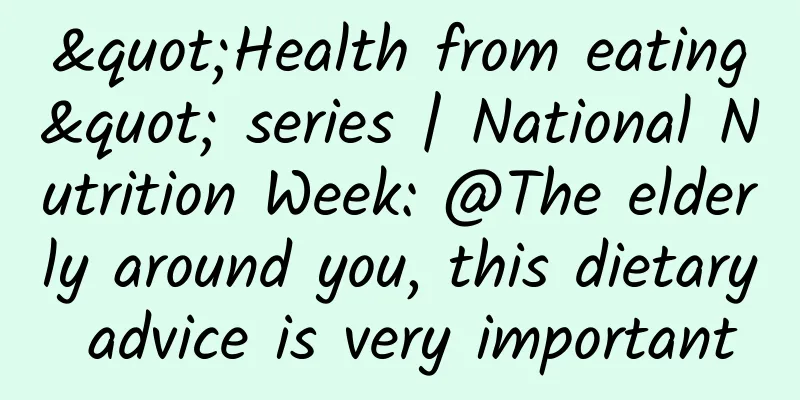Can eating the right snacks help you live longer? Foodies finally have a reason

|
Key Points ★ Treat snacks rationally: choosing the right ones can supplement nutrition and benefit the body; choosing the wrong ones can harm your health. ★ Choose more natural and healthy snacks, such as nuts, fruits, dairy products, etc.; try to limit the consumption of high-sugar, high-salt, and high-fat snacks, such as ham, potato chips, spicy strips, etc. ★ Snacks should not be eaten more than three times a day, and should be separated from regular meals by 1.5 to 2 hours. Recently, a study published in the Journal of the American Heart Association showed that the best snack after breakfast is fruit, and the best snack after dinner is milk or dairy products. This combination helps regulate the body's metabolism and significantly reduces the risk of death from cardiovascular disease and cancer. In other words: eating the right snacks can help prolong your life. Screenshot of the paper Many people have always regarded snacks as a "disaster". Many people want to eat but dare not, for fear that they will get fat or harm their health. However, the results of this study in the United States are like a bolt from the blue, which not only overturned the long-standing negative perception of snacks among the public, but also made many foodies very happy: they can finally enjoy snacks with peace of mind! But don't be too happy too soon! (Singing): Your snacks and my snacks may be different. Not all snacks can prolong your life, but only if you eat them right. Next, let's talk about how to choose the right snacks! 01 What are good snacks? Healthy foods besides meals Snacks are actually snacks that are not eaten during meals. Any small amount of food or drink eaten at other times is considered a snack. Eating snacks properly can replenish energy and nutrition for the human body. There are a hundred Hamlets in the eyes of a hundred people, and different people have different understandings of snacks. Some people think that potato chips, French fries, spicy strips, rice crust, chocolate... these are snacks, and of course these are the snacks that most people eat more often. However, these snacks are generally high in oil, salt, sugar, and energy, and are not good for health. The picture comes from the Internet The snacks described in this study published in the Journal of the American Heart Association are certainly not these unhealthy snacks, but healthier foods, such as fruits, dairy products, nuts, etc. 02 How to eat snacks? Control the time and amount Now that we have a clear definition of healthy snacks, let’s tackle the question of “when to eat” and “how much should you eat per day”! Snacks should be eaten between two meals, preferably 1.5 to 2 hours apart from the main meals, to avoid affecting the main meals. Snacks should be eaten ≤ 3 times a day, and you should rinse your mouth and clean your mouth after each snack. It should be noted that you should not eat before going to bed, as eating snacks before going to bed will not only increase the burden on gastrointestinal digestion and absorption, but also damage dental health. Daily snack suggestions: 200-350g fruit 300~500 ml milk 10g plain nuts (such as 1 paper-shell walnut or 7-8 cashews/almonds/pistachios) 03 Look at the labels carefully to avoid pitfalls when choosing snacks Although we advocate choosing more natural foods as snacks, we may occasionally eat some pre-packaged snacks to satisfy our cravings. This requires everyone to do one thing before buying snacks: read the food labels carefully. Mainly look at three points: ingredient list, nutritional composition table, production date and shelf life. ▶Ingredients: According to the General Rules for Pre-packaged Food Labeling, food packaging ingredient lists must be arranged in order of quantity, that is, the higher the list, the more added. Therefore, when choosing pre-packaged snacks, you should first look at the ingredient list, especially the following two aspects: ① Do not choose snacks that are high in added sugar. According to the "Dietary Guidelines for Chinese Residents", the daily intake of added sugar per person should not exceed 50 grams, and it is best to control it below 25 grams [1]. Excessive sugar intake will increase the risk of dental caries and obesity. Common added sugars include: white sugar, fructose syrup, maltose syrup, honey, brown sugar, rock sugar, etc. ② Do not choose snacks containing trans fats. Regular intake of trans fatty acids increases the risk of obesity and cardiovascular disease [2]. So, how do you determine whether a food contains trans fatty acids? When you see ingredients such as hydrogenated vegetable oil, refined vegetable oil, margarine, artificial butter, non-dairy creamer, shortening, and cocoa butter substitute in the ingredient list, it means that it may contain trans fatty acids. ▲Chocolate bar of a certain brand Some careful friends may find a problem: the above ingredients clearly appear in the ingredient list, but the trans fatty acids in the nutritional table are marked as "0". What's going on? According to the "General Rules for Nutrition Labeling of Pre-packaged Foods", when the trans fatty acid content is ≤0.3g/100g (solid) or 100mL (liquid), it means that the content of trans fatty acids is very small, and the words "no or does not contain trans fatty acids" can be marked on the food packaging. ▲Nutrition composition table of a certain brand of chocolate bar ▶Nutrition Information: By using the data on the nutritional information table, we can accurately choose snacks with relatively low energy, fat, sodium, and sugar content. However, you also need to understand the following four points: ① Energy: The energy unit on the nutrition facts table is generally kilojoule (KJ). If you want to convert it to kcal (kcal), you need to divide the value of kilojoule by 4.184 to get the data of kcal. For example, the chocolate bar in the picture above has an energy of 2038÷4.184=487 kcal per 100 grams. ② Sugar content: Currently, the national standard does not require manufacturers to indicate the sugar content in the nutrition information table, so the calculation of sugar content is more applicable to sweet drinks (the carbohydrates in drinks are mainly added sugars). Divide the carbohydrate content in the nutrition information table by 4.5 (each sugar cube contains about 4.5g of sugar), and you will get the corresponding number of sugar cubes. For example, the sweet drink in the picture below: the sugar content in every 100 ml is 12÷4.5≈2.7 sugar cubes, and a bottle is 1L. Even if you drink half a bottle, which is 500 ml, the sugar content you ingest is not low, equivalent to nearly 14 sugar cubes. The picture comes from the Internet ③ Salt content: The "Dietary Guidelines for Chinese Residents" recommends that the daily salt intake per person should be less than 6 grams, which includes not only the table salt we usually use for cooking, but also the invisible salt that we cannot see. Many packaged snacks are "heavily affected" by salt, such as plums, spicy strips, potato chips, and rice crusts... It is actually very simple to calculate their salt content. Just divide the sodium content in the nutrition facts table by 400 and you will get the salt content! For example, the picture below shows a spicy strip that everyone likes to eat. The salt content per 100 grams is 2128÷400=5.32 grams. A bag of spicy strips weighs 78 grams. If you eat a whole bag, you will consume about 4 grams of salt, which is nearly 67% of the recommended limit of 6 grams. If you eat some vegetables, it is easy to exceed the sodium intake limit. ▲Nutritional composition table of a certain brand of spicy strips ④ Fat content: Compared with the above indicators, fat content is the easiest to judge. The amount written on the nutrition information table is the amount in grams, and no conversion is required. Take the spicy strips mentioned above as an example. Every 100 grams of spicy strips contains 25 grams of fat. Eating a 78g bag of spicy strips will consume nearly 20 grams of fat, which is about 33% of the nutrient reference value. In addition, for adults, fat energy should account for less than 30% of total energy. Therefore, when buying snacks, you must take a look at the data on the nutritional information table and do a simple conversion to get a rough idea. The general direction is of course to try to choose snacks with low energy, low salt, low sugar and low fat. ▶Production date and shelf life: This is easy. We all know that we should choose the products closest to the production date as much as possible, so as to ensure the freshness of the food to the greatest extent. In addition, we should also pay attention to the storage method to avoid premature deterioration of food due to improper storage conditions. References: [1] Chinese Nutrition Society. Dietary Guidelines for Chinese Residents[M]. People's Medical Publishing House, 2016 [2] Tong Zhigang. Current status of research on the relationship between trans fatty acids and cardiovascular diseases[J]. Practical Clinical Medicine, 2010, 06(v.11):139-141. Author | Xue Qingxin, member of Chinese Nutrition Society, registered dietitian, registered nutrition technician, health manager, public nutritionist Review | Zhang Jiguo, Researcher, Institute of Nutrition and Health, Chinese Center for Disease Control and Prevention This article was first published on Science Refutes Rumors |
Recommend
What mobile phones are used in other countries? See the market share distribution chart to find out
This is an era of data interconnection and smartp...
Investigation Report on "Human Assets" in Guanghan Palace
Since the first visit to the moon, humans have le...
BYD: No one can beat them? Volkswagen: Wait for me to come and learn a few tricks!
"BMW withdraws from price war" became a...
Why don't elephants and whales get cancer?
Author: Denovo It is well known that cancer is ca...
Is it a tragedy that China Unicom and China Telecom do not have FDD licenses in the 4G era?
Recently, the online article "China Unicom fo...
iOS componentization is not just the architect's job
iOS componentization was once a hot topic in the ...
Why is it that the articles you write are very valuable but no one reposts them?
Take “Cool Play Lab”, an article with over 100,000...
These 3 types of people are really not suitable for naps! Check if it’s you
Spring sleepiness, summer fatigue, autumn naps, a...
How much does it cost to rent an IDC computer room?
How much does it cost to rent an IDC computer roo...
Can Samsung TV, which is determined not to produce OLED, still gain a foothold in the future TV market?
If the industry's most important mobile phone...
Dragon Boat Festival holiday schedule 2022: How many days off? Is the highway free?
The Dragon Boat Festival, also known as the Duan ...
The pH standard of sanitary napkins has caused controversy. It is not reliable to only look at the pH!
Review expert: Wang Xuejiang, professor at Capita...
As the iPhone’s “remaining power” is about to fade, how can the smartphone industry survive the “ten-year itch”?
It turns out that not only our country’s economy ...
[Creative Cultivation Program] Getting angry can actually cause poisoning?! In the hot summer, you need to calm down and cool down naturally
Author: Chen Wen Reviewer: Department of Neurolog...
Mid-year shopping festival 618, let's take a look at the routines of online activities
Now, as long as you open the various shopping app...









